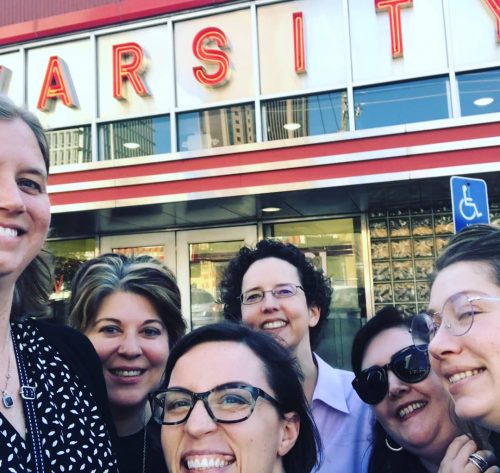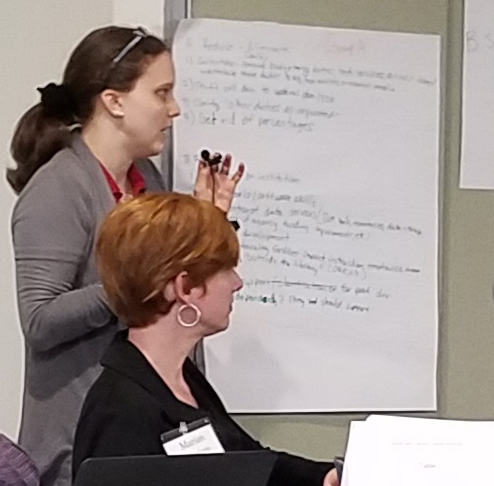This article is more than 5 years old.
On April 26, Kathy and Kaeley attended the ASERL Intersections of Scholarly Communication and IL workshop, which was held on the campus of Georgia Tech in midtown Atlanta [slides are available on the ASERL site]. Molly already shared her experience at this conference from a director/scholarly communication librarian perspective, so Kaeley and I will share what we learned from the research and instruction/IL side. One of the first activities that we did in our groups was to create definitions for IL and schol comm, and then create a graphic to show how they overlap. Through our discussion, we found that a lot of what we do in library instruction involves scholarly communication to some degree. Our primary task for this workshop was to create a learning experience for a particular audience around this intersection. Kaeley and I chose to focus on a learning experience for a LIB 200-level course to help students understand the bigger picture of scholarly communication and their place in it. We developed a learning outcome and then brainstormed some activities we might create to address that learning outcome. Personally, I got some great ideas that I am eager to talk to Molly and Hu about for LIB 210!
The fun continued on April 27-28, when Carol, Kaeley, and I attended the ASERL/ARL Liaison Institute, which was held at the same location as the Schol Comm workshop the day before.
We heard a keynote from Anne Kenney, University Librarian Emerita at Cornell, who helped develop the first liaison institute there. Anne spoke about may of the factors outside the library that are impacting our work, including issues within higher education, the increasing focus on global engagement, and the imperative to be collaborative. She described some of the inadequacies of the current liaison approach, such as program stasis, turf issues, and the “last mile” issue as related to communicating the great things that we do to our community. She went on to provide some potential strategies for moving forward, which are also outlined in an issue brief for Ithaka S+R.
We then moved on to some small group activities. Our facilitators for the rest of the day, Rita Vine and Elizabeth Waraska, were both from ARL and have been holding this institute in different places around the country [slides are available on the ASERL site]. I (Kathy) was in a group with librarians from a variety of institutions, including the University of Miami, Tulane, University of Virginia, University of Mississippi, and UNC Greensboro. We worked through a document outlining liaison competencies and discussed which responsibilities we would reduce and which we would add, and we didn’t necessarily agree on all of those, which highlighted differences in our institutional contexts as well as the disciplinary areas that we supported. After lunch, we merged with another group to work through hypothetical scenarios that we might face and how we thought those matched up with the competencies we articulated in the previous exercise. The last activity for the afternoon was a series of round robin discussions that asked us to further reflect and discuss ways we were or could be innovating to support our liaison areas.
On Saturday, we started the day off with an Unconference, where the facilitators drew from topics submitted from participants the day before to develop six topics for round robin discussions, including: What can liaisons do to sustainably support/advance student learning outcomes?; Leveraging students and faculty for engagement, outreach, and research support; How can we self-assess our impact?; How can administrators change performance criteria to support 21st century liaisons? Each topic was discussed by 2 different sets of participants, and at the end we all reported out what we gained from the discussion. At the end, we were given a chance to meet up with the people from our home institution to check in and think about what we wanted to report back and how we might use what we learned back at our library.
Kathy’s takeaways:
- I came away with a better understanding of the resources provided by ASERL and ARL to support liaison work, such as the Reimagining the Library Liaison initiative. Martin Tsang, who was in my group, shared his work around asking faculty open-ended questions – Tips and Sample Questions are available on the ARL site.
- The Institute leaders and other liaisons emphasized multiple times that we need to make clear how what we do aligns with the larger university goals, particularly in terms of learning outcomes. I’ll be interested to see what comes out of the curriculum review information literacy subcommittee that Roz is currently on. I’m also thinking about what areas of liaison work I want to grow in so that I can be better positioned to support new initiatives on campus.
- There are SO many different liaison models out there, and it’s clear that it’s not one-size-fits-all. Some liaisons do everything for a particular department, others have clearly delineated who does collection development and who does reference and instruction, while others have left collection development almost entirely to approval plans to focus on other tasks. You have to find a structure that works for your institutional culture, staff size, and goals.
Kaeley’s thoughts:
- Assessment is a constant topic these days, and the first of the unconference groups I met with discussed “How can liaisons self-assess their impact?”. Other attendees shared program level assessments (Core Competencies for Subject Librarians and the Florida State University Libraries), small-scale service surveys (“Thank you for using our service, please rate us.” using 🙂 or 🙁 or 1-10), as well as the problem of how to get data from those who didn’t use your service. It was also stressed by multiple librarians that it is important to move beyond numbers and collect narrative assessments that reflect the relationships liaisons build with their faculty and students. Which is more important, the number of interactions or the quality and results of those interactions?
- I’m always scribbling down resources that are mentioned at conferences, hoping that I can track them down later! Two assessment related resources that came up in my unconference discussion and in the wrap-up session were Assessing Liaison Librarians (and ebook) from ACRL and HuMetricsHSS. The Humane Metrics Initiative is looking at evaluating academics via metrics that assess these five values: collegiality, quality, equity, openness, and community. I appreciate the way they are framing this discussion and it looks like their blog has some helpful posts that I need to check out!
- A few other random thoughts:
- “When ARL stops asking for for reference statistics, we will stop collecting them!”
- No liaison program will be a fit for every liaison, liaisons should be allowed to craft a program that fits them and their departmental relationships
- If we are working as teams we need to move away from highlighting our individual achievements
- We should have a liaison program meet-up at the NCLA conference
We also met up with some colleagues from UNCG at an Atlanta institution, the Varsity! #awkwardgroupselfie

Carol’s observations:
The term “functional specialist” is often used when discussing liaison roles. During the institute, I observed that the term is more likely to be used for newer and emerging specialties (e.g. Data Services Librarian), but is less likely to be used with more classic functions, like Government Documents Librarian. Why is that?
When tables were asked to brainstorm what liaisons could stop doing, “buying books” was often mentioned (as was “reference desk hours”). I’m scared to ask how people here feel about selecting books, but I probably should, as this idea was mentioned by almost every table.
Some specific ideas from my “unconference” station:
- Fund compression, e.g. all science journals on one fund.
- Use tools like Find a Journal to do accreditation reports if you have compressed funds.
- Eliminate collection development policies (the defender of the policies at our table mentioned that it bolsters you when you need to say “no” – something we don’t like to do anyway).
- Replace collection development policies with “department profiles.” This idea was controversial at the library that implemented it. At WFU, some of that data already exists on our Liaison Dashboard.
One nice bonus from this experience was catching up with Megan Bennett. I first met her when she worked with Resource Services as a high schooler during the summer. Over the years, she has encountered various ZSR folks as she went through college and library school. Now she’s beginning her professional career at the University of Alabama.

Megan makes a point. Photo definitely not by Ken Bennett.

4 Comments on ‘ASERL Schol Comm and IL workshop + ASERL/ARL Liaison Institute in Atlanta’
Nice write up of a busy few days. I’d love to explore some of the topics you’ve uncovered here. Schol Comm/IL overlap is intriguing, as is the assessment and the changing model of liaisons. So I guess we should talk!
Glad to see that assessment was part of the agenda. So important and so hard to do! Looks like you gathered some good insights/ideas.
Definitely sounds like the fun continued after I departed Atlanta! Kathy, I look forward to hearing your thoughts for LIB 210. Kaeley, the Humane Metrics Initiatives is fascinating–I’ve not heard of it, but it immediately resonates. And Carol, don’t be afraid to ask the questions you don’t want to hear the answers to. 😉
I took a little time to read some of the materials linked from this post and it was thought-provoking. One major take-away was that we are already doing a lot of things right, particularly in that our liaisons do work to build strong relationships with faculty and to connect with students at point of need. I think I’ll end up having a number of informal individual conversations as I process the information I gained from reading this collaborative post and the associated readings!